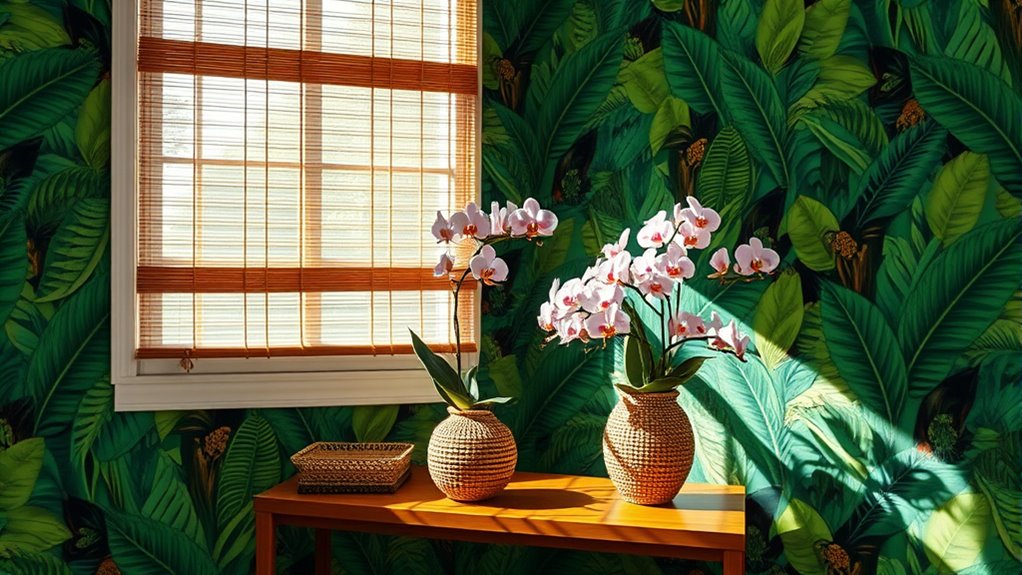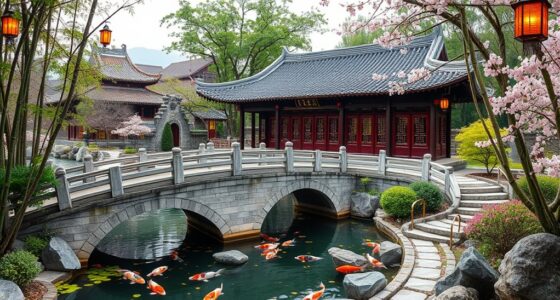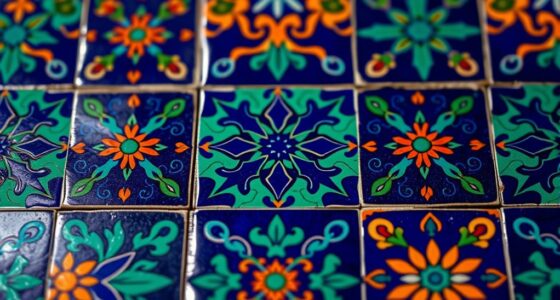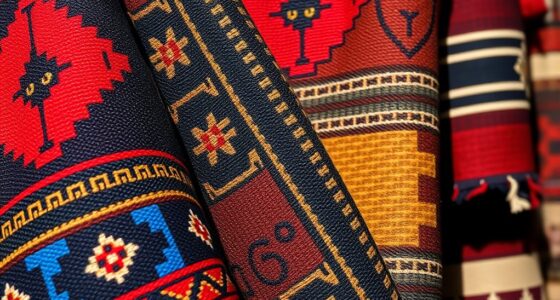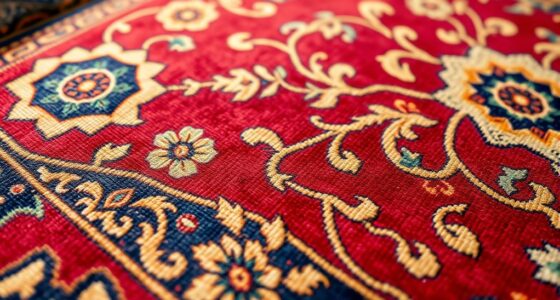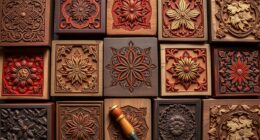Tropical patterns originate from indigenous cultures that use natural symbols like palm leaves, flowers, and native animals in textiles, carvings, and pottery. Thanks to colonial trade routes, these motifs spread worldwide and influenced European art, becoming symbols of luxury and adventure. In recent decades, tropical designs surged in fashion and home decor, blending exotic beauty with modern sustainability. To see how these patterns evolved and continue to inspire, explore further into their fascinating history and cultural significance.
Key Takeaways
- Tropical patterns originate from indigenous craft, depicting natural elements like palm leaves, flowers, and animals, serving cultural and spiritual purposes.
- During colonial times, trade spread tropical motifs worldwide, symbolizing luxury, exploration, and exotic appeal in textiles and decorative arts.
- In the 20th century, tropical patterns gained popularity in fashion and interior decor, evoking escapism and a connection to nature.
- Contemporary trends blend tropical motifs with sustainability, emphasizing eco-friendly textiles and responsible design.
- These patterns continue to symbolize luxury and ecological consciousness, shaping modern interior aesthetics and future design innovations.
Origins of Tropical Motifs in Indigenous Cultures

Have you ever wondered where tropical motifs in decor come from? These patterns originate from indigenous craft, where local communities used natural symbolism to express their connection to the environment. They often depict elements like palm leaves, flowers, and animals native to the region, reflecting a deep respect for nature. Indigenous artisans incorporated these symbols into textiles, carvings, and pottery, blending functionality with artistic expression. These motifs serve as cultural identifiers, telling stories and conveying spiritual beliefs rooted in the land. The use of natural symbolism highlights the significance of nature in everyday life and spiritual practices. Additionally, cultural expressions through these patterns serve as a form of storytelling, preserving history and traditions. By understanding these origins, you gain a richer appreciation for how tropical patterns embody cultural heritage and the environment’s essential role in indigenous communities.
The Influence of Colonial Exports and Trade

The exchange of goods and ideas during colonial periods considerably shaped the popularity and spread of tropical patterns in decor. Colonial influence introduced exotic motifs through established trade routes, making these designs accessible worldwide. As traders transported goods like textiles, ceramics, and botanical specimens, tropical motifs gained prominence in European and American homes. Additionally, the use of natural materials in these patterns further emphasized the authenticity and appeal of tropical decor.
Trade routes and colonial influence spread tropical patterns worldwide, enriching decor with exotic motifs and vibrant designs.
- Trade routes facilitated the dissemination of vibrant fabrics and decorative arts featuring tropical flora and fauna
- Colonial exports brought new materials and styles that merged with local traditions
- Tropical motifs became symbols of luxury and adventure, appealing to European tastes
- The visual language of these patterns reflected both exotic appeal and colonial power dynamics
You now see how trade routes and colonial influence played key roles in embedding tropical patterns into global decor traditions.
Incorporation Into European Artistic Traditions
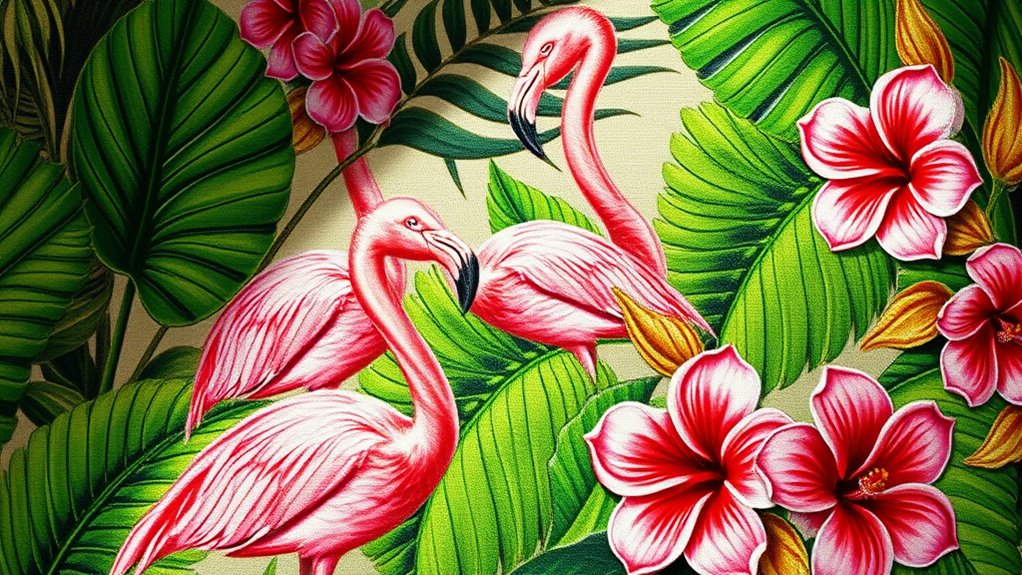
As tropical motifs gained popularity through trade and colonial exchanges, European artists and designers began integrating these vibrant patterns into their own artistic traditions. They embraced tropical symbolism and botanical symbolism, blending exotic flora with classical motifs. This fusion influenced decorative arts, from textiles to ceramics, enriching European aesthetics. The following table highlights key patterns and their origins:
| Pattern Type | Tropical Elements | Artistic Influence |
|---|---|---|
| Chinoiserie | Exotic bamboo and palms | Rococo and chinoiserie styles |
| Botanical Prints | Ferns, orchids, monstera | Naturalist movement |
| Foliate Motifs | Leafy patterns, vines | Baroque and Rococo ornamentation |
This integration reflects how tropical imagery became a symbol of luxury and exploration, shaping European artistic expression. Additionally, the adaptation of these patterns facilitated a broader appreciation for exotic environments and contributed to a fascination with distant lands within European art.
The Rise of Tropical Patterns in 20th Century Fashion and Interior Design
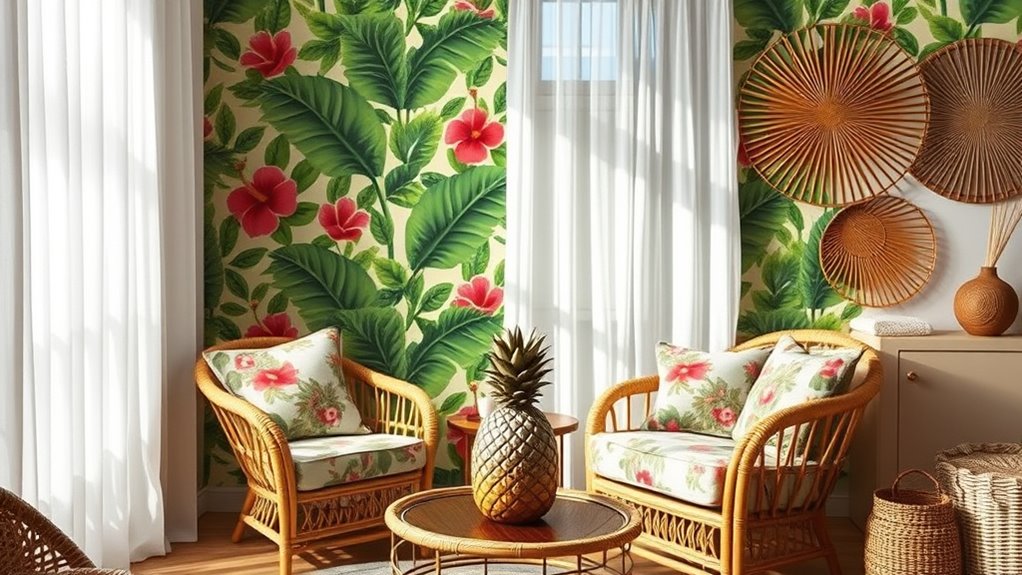
Throughout the 20th century, tropical patterns surged in popularity, transforming fashion and interior design into vibrant expressions of exotic allure. You notice how designers incorporate tropical symbolism to evoke a sense of escape and adventure. Fashion adaptation plays a key role, with tropical motifs appearing on everything from swimwear to accessories, making bold statements. This trend also influences interior spaces, bringing lively patterns indoors. You might see tropical prints on upholstery, curtains, or wallpaper, creating a relaxed yet luxurious atmosphere. The popularity of these patterns reflects a desire for escapism and connection to nature. As you explore further, you’ll find that these vibrant designs continue to inspire contemporary styles, blending the exotic with everyday life seamlessly.
- Use of tropical symbolism to evoke escapism
- Fashion adaptation of patterns on clothing and accessories
- Interior decor featuring lively tropical prints
- Desire for connection to nature and luxury
Iconic Examples and Cultural Symbols in Tropical Decor
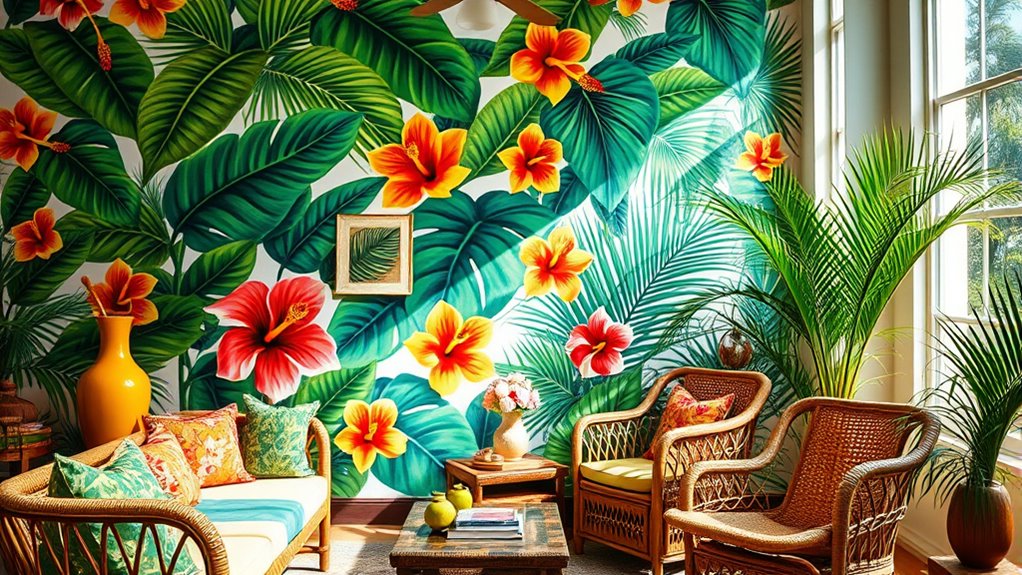
What makes certain tropical motifs instantly recognizable are their cultural symbols and iconic elements that have become staples in decor. Exotic fauna, like toucans, parrots, and colorful butterflies, often serve as eye-catching focal points that evoke a sense of adventure and nature’s vibrancy. Lush foliage, including palm leaves, banana plants, and ferns, forms the backbone of tropical decor, creating a lush, immersive environment. These symbols are deeply rooted in the regions they represent, making them powerful cultural icons. Their bold patterns and vivid colors transcend mere decoration, reflecting the richness of tropical ecosystems and cultural heritage. By incorporating these well-known elements, you bring a piece of the tropics into your space, celebrating the beauty and diversity of exotic flora and fauna.
Modern Interpretations and Global Trends
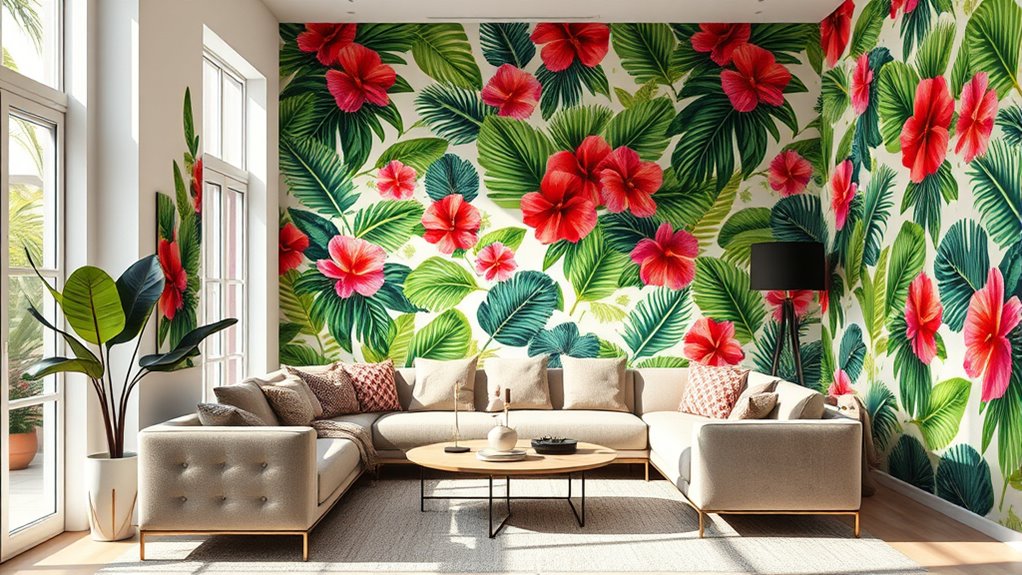
Modern interpretations of tropical decor blend traditional motifs with contemporary aesthetics, making the style more versatile and widely appealing. You’ll see global trends influencing how tropical patterns are used in interior design today. These trends include minimalistic takes on bold foliage, the use of sustainable materials, and innovative color palettes that refresh classic themes. Additionally, the popularity of preppy dog names reflects a broader trend toward personalized and stylish design choices in home decor.
Modern tropical decor fuses traditional motifs with sleek, sustainable design for versatile, trend-forward interiors.
- Incorporation of eco-friendly fabrics and furnishings
- Bold, oversized botanical prints in modern settings
- Neutral backgrounds highlighting vibrant tropical accents
- Mixing traditional motifs with sleek, minimalist furniture
Contemporary interpretations often emphasize simplicity and sustainability, appealing to a broad audience. As global trends evolve, tropical decor adapts, blending cultural influences with modern design principles. This fusion creates fresh, dynamic spaces that honor tradition while embracing current styles.
The Enduring Appeal and Future of Tropical Patterns
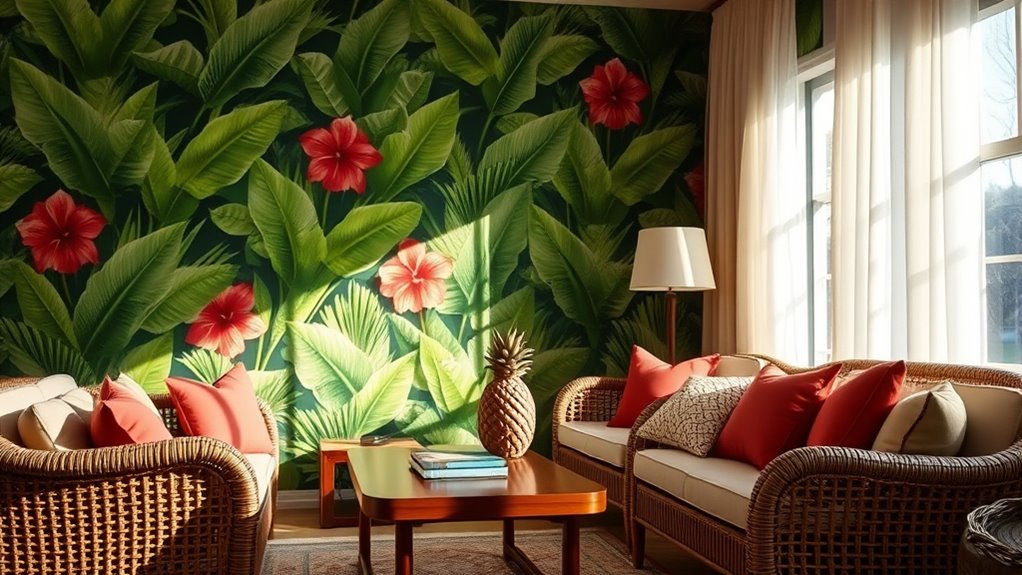
Tropical patterns have secured their place in interior design because of their timeless appeal and ability to evoke a sense of paradise. Their enduring charm attracts luxury branding, where these vibrant motifs symbolize sophistication and escape. Looking ahead, the future of tropical patterns lies in sustainability; designers increasingly turn to eco friendly textiles that preserve the environment without sacrificing style. This shift reflects a growing consumer demand for eco-conscious choices, ensuring tropical decor remains relevant. As trends evolve, you’ll see tropical patterns integrated into minimalist and modern aesthetics, blending tradition with innovation. Their versatility and cultural richness promise continued popularity, inspiring future designs that balance elegance with ecological responsibility. Additionally, the integration of sustainable textiles into tropical patterns will further enhance their appeal and longevity. Tropical patterns are here to stay, embodying both luxury and sustainability for generations to come.
Frequently Asked Questions
How Do Tropical Patterns Influence Contemporary Sustainable Design Practices?
Tropical patterns influence contemporary sustainable design by encouraging the use of eco-friendly textiles and supporting local craftsmanship. When you incorporate these patterns, you promote environmentally conscious choices, like natural fibers and low-impact dyes, reducing your ecological footprint. Additionally, sourcing from local artisans helps sustain traditional skills and minimizes transportation emissions. This blend of vibrant aesthetics and sustainability empowers you to create stylish, eco-conscious spaces that honor cultural heritage and protect the environment.
Are There Regional Variations in Tropical Pattern Styles Worldwide?
Yes, regional variations in tropical pattern styles worldwide reflect unique cultural influences and local motifs. You’ll notice Caribbean designs often feature vibrant florals and bold colors inspired by island life, while Southeast Asian styles incorporate intricate, nature-inspired motifs with a touch of spirituality. In Africa, tropical patterns may include tribal motifs and earthy tones. These differences celebrate diverse cultural identities, making each tropical pattern style distinct and meaningful across regions.
What Role Do Tropical Patterns Play in Cultural Identity Preservation?
You might think tropical patterns just make your room feel lively, but they actually serve as vibrant symbols of cultural identity. By embracing these designs, you preserve cultural symbolism and celebrate traditional craftsmanship. Every leaf or flower echoes heritage and history, reminding you that decorating isn’t just about aesthetics but about honoring roots. So, next time you choose a tropical motif, remember you’re actively participating in cultural preservation—one pattern at a time.
How Have Digital Technologies Transformed Tropical Pattern Creation?
Digital tools have revolutionized tropical pattern creation by enabling you to experiment with pattern innovation easily. You can now design intricate, vibrant patterns using software like Adobe Illustrator or Photoshop, which were hard to achieve manually. These technologies allow for quick modifications, perfect color matching, and sharing your designs globally. As a result, you can push creative boundaries and bring fresh, dynamic tropical patterns to life more efficiently than ever before.
Can Tropical Designs Be Ethically Sourced and Produced Globally?
Yes, tropical designs can be ethically sourced and produced globally. You can choose brands that prioritize ethical sourcing by ensuring fair labor practices and sustainable materials. When supporting global production, it’s important to verify transparency in supply chains and certification standards. By doing so, you help promote responsible practices that respect both people and the environment, making sure your tropical decor choices are both beautiful and ethically sound.
Conclusion
You can’t deny that tropical patterns have taken over your world, transforming everything from your home to your wardrobe into a lush paradise. Their vibrant, exotic designs are more than just decor—they’re a cultural phenomenon that’s impossible to ignore. As they continue to evolve and captivate, you’ll find yourself immersed in an endless tropical paradise, feeling like you’ve stepped into a perpetual vacation. The future of these patterns is brighter—and more irresistible—than you ever imagined.

